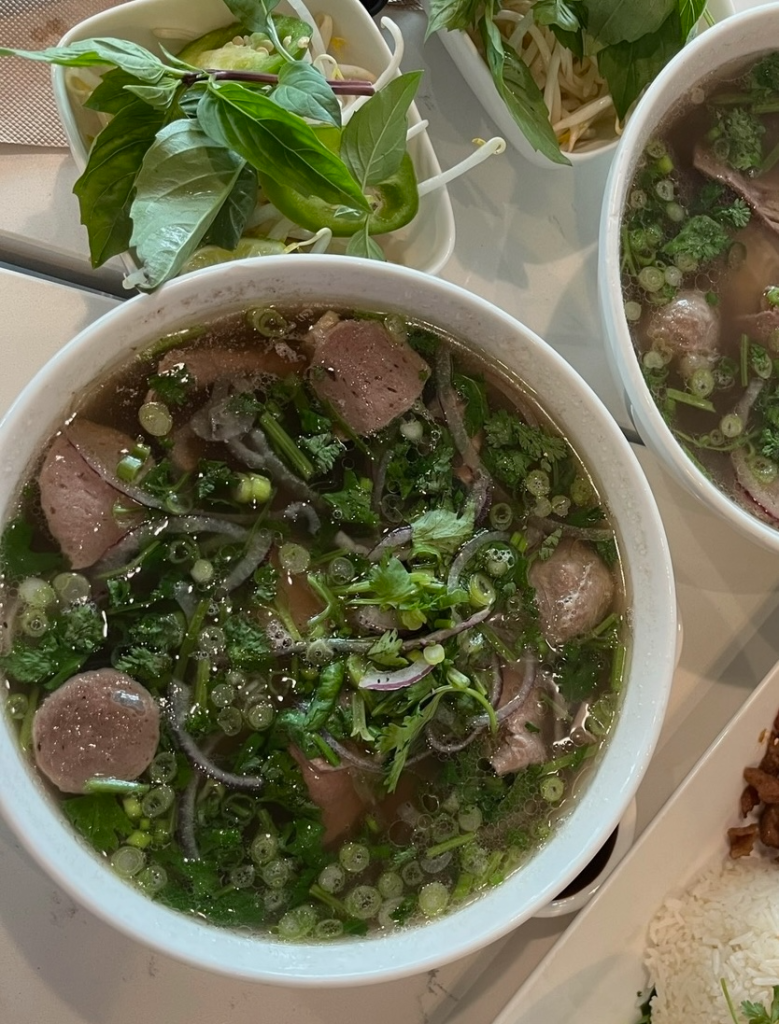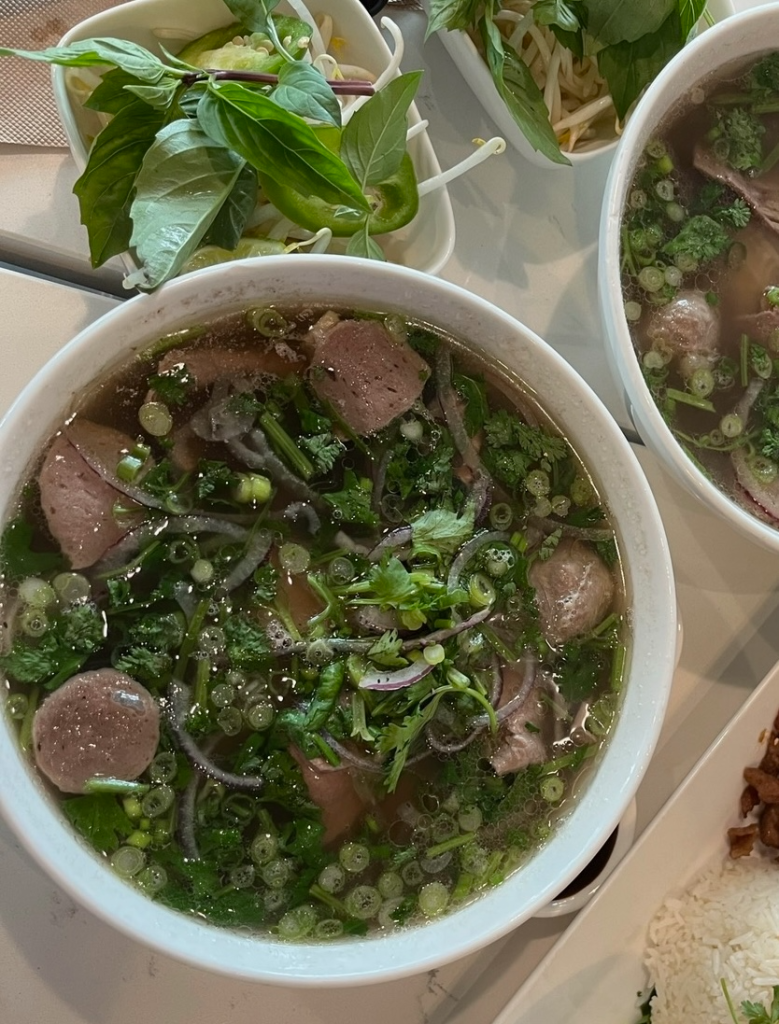
A mouthwatering bowl of pho—a rice noodle dish from Vietnam. Pho is one of the most popular Asian dishes here in the United States and could be considered to be one of the staples in Asian cuisine. Photo by Jiana Abalos
From crunchy egg rolls to chewy tapioca boba pearls, Asian cuisine is receiving a massive warm-welcome around the world, and especially here in the United States. Asian cuisine consists of diverse dishes that date back to ancient times, with ingredients native to each respective region and country.
In honor of May being recognized as the Asian American and Pacific Islander History Month, I will be guiding you through Asian cuisine from East Asia, South Asia, Central Asia, and West Asia, with an emphasis on Southeast Asian cuisine. Each food I introduce will be traditional food from each country, and will not be “Americanized” like orange chicken and mongolian beef from Panda Express. So grab your tickets, your tummy, and your palate, because we’re sailing across the vast Pacific Ocean to the continent of Asia.
East Asia
To kick off this guide, we will begin our journey by trying food from the largest country in Asia—China. Since it’s a huge country that consists of many different cultures and customs, China has eight different cuisines: Anhui, Cantonese, Fujian, Hunan, Jiangsu, Shandong, Sichuan, and Zhejiang cuisines. When some people think about Chinese food, greasy foods such as orange chicken, chow mein, and mongolian beef would probably come to mind. In contrast to those “unhealthy” brands on the cuisine, authentic Chinese food is actually one of the healthiest in the world, with an emphasis on fresh ingredients for health and medicinal purposes. Since rice noodles and soups are one of the staples, the dish I’ll be introducing today (and actually one of my favorites) is xiao long bao, or soup dumplings, and zha jiang mian: Beijing’s signature noodles.
Not to be confused with Korea’s jajangmyeon, the dish pictured above is zha jiang mian, or Beijing fried sauce noodles. This dish was popularized in Korea, but it originated in China. This Beijing version contains yellow soybean paste that is used as the main seasoning, and is also filled with diced pork or chicken and vegetables. It’s a bit sweet, and also easy to eat.
The Middle East, or
West Asia
The Middle East’s cuisine incorporates wheat and rice as their staple, where rice is typically served with grilled or stewed meat, and vegetables underneath the rice. Since it’s also a region with a diverse range of people with different cultural backgrounds and religions, some parts of the region cannot consume pork for religious reasons; they instead resort to other meats like lamb or chicken. So I tried the lamb shawarma, and the lamb shawarma rice.
This dish is traditionally served with lamb, chicken, or turkey in a large cone-shaped skewer. It can be confused with gyro, but the latter is served with beef, chicken, or pork. Shawarma is a flavorful dish thanks to the creamy sauces and fresh vegetables, and is also served with pita—a type of flatbread that originated in the Middle East.
Similar to shawarma, this slow-cooked and flavorful lamb dish is served with pilaf rice and often fresh or pickled vegetables, with a yogurt sauce and hummus. This dish is also common and traditionally specific to Arabic countries. It is an explosion of flavor, but not overpowering. The lamb strips were also flavorful, especially when paired with the yogurt sauce.
Southeast Asia
This article will put a huge emphasis on this region of Asia (because it’s where I’m from, duh). Just like any other Asian cuisine, the Southeast Asian cuisine’s staple is rice and noodles. Cuisines might share some flavors and ingredients, but they still have a distinct difference between them. Each country’s cuisine contains their own unique history, with the Vietnamese cuisine being influenced by French food, and the Philippine cuisine being influenced by Spanish and American food, due to colonization. Southeast Asian cuisine is one of the rising cuisines worldwide, with people flocking over the steamy and flavorful broth of Pho, and to the spicy and fiery Thai foods.
Our Southeast Asian tour will begin in Thailand, with Pad Thai and Tom Kha Gai, or Thai Coconut Chicken Soup.
This has to be one of my favorite noodle dishes ever. Pad Thai is a stir fried noodle dish that has a sweet and savory sauce. It is traditionally mixed with shrimp if authentic, but it could also be served with beef, chicken, and tofu. It is also served with peanuts on the side, and bean sprouts. It is also best paired with Thai Tea!
This soup from Thailand called Tom Kha Gai is unique because it has a creamy coconut broth. It’s sweet, tangy, salty, and a bit spicy—all the good stuff. It’s also an easy introduction to Thai food, because it’s easy to eat and not too strong.
Next on the stop is Vietnam. One of the most popular Asian dishes came from this cuisine, with Phở on top of this list.
Pho is traditionally made with beef broth, different meat toppings (such as meat balls, brisket, flank, or tripe) as well as a variety of vegetables and herbs, and rice noodles. You could customize this dish too by adding sriracha, or other toppings like bean sprouts. It’s a perfect soup if you want something refreshing and savory.
A kati roll is an Indian style wrap filled with spiced mixed veggies and grilled kebabs, or skewers. It is chewy, spicy, and tangy. It is also served with cream yogurt or chutney sauces. The wrap is called a paratha, which is a flaky Indian flatbread.
Now that our trip to the Asian continent has ended, I think it’s the perfect time to immerse ourselves in the culture and cuisines even when we’re far away. It’s Asian American and Pacific Islander Heritage Month, so it’s also the perfect time to support our local businesses. Asian cuisine contains a wide array of dishes, and exploring each cuisine is a fun way to get immersed into the culture and find your new favorite food!


































